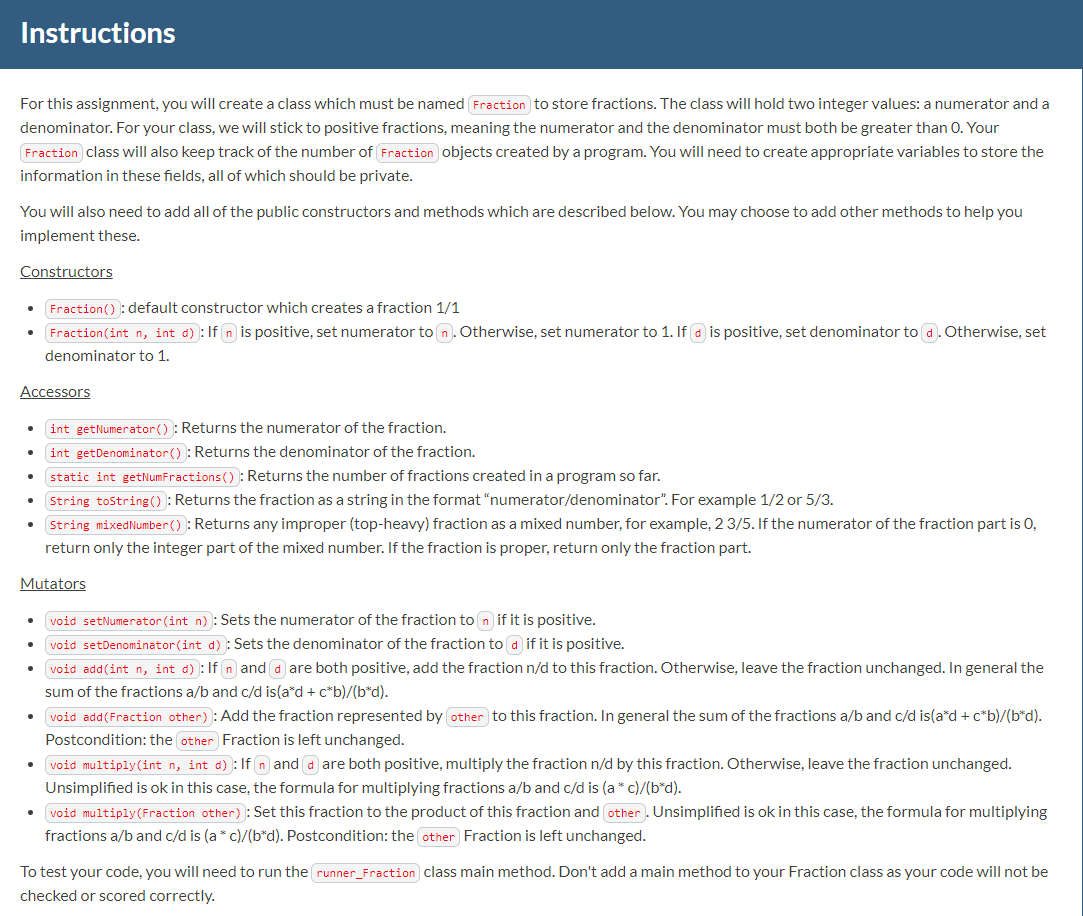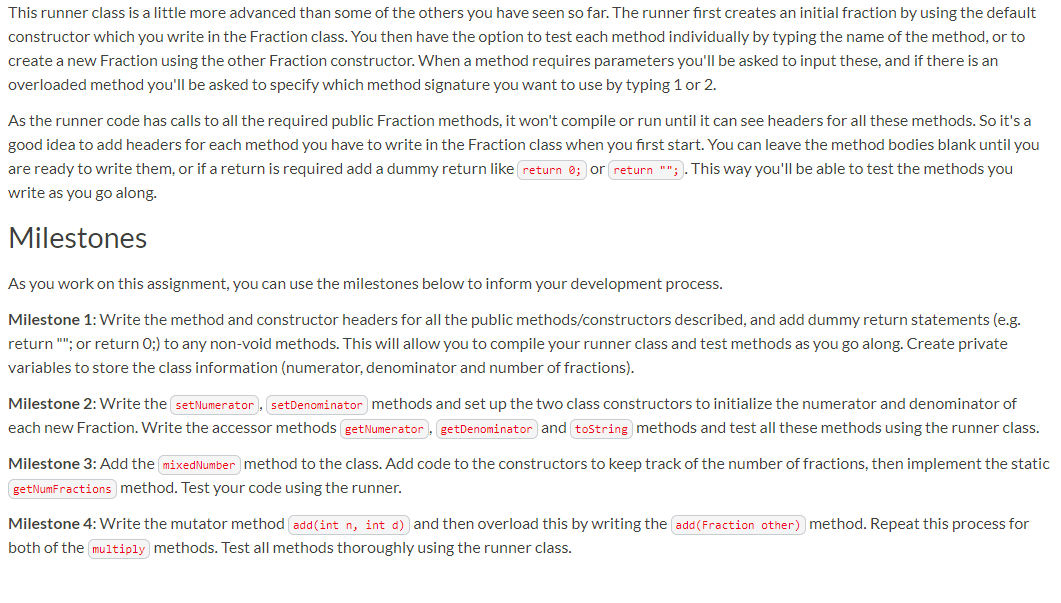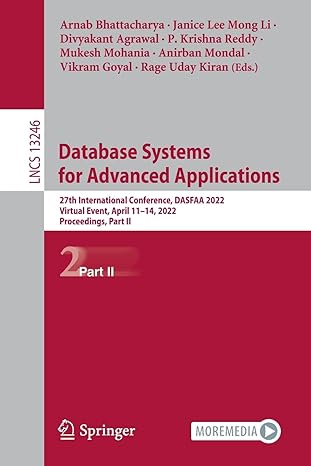Question
This is runner code: import java.util.Scanner; public class runner_Fraction{ public static void main(String[] args){ Scanner scan = new Scanner(System.in); Fraction f = new Fraction(); String


 This is runner code:
This is runner code:
import java.util.Scanner;
public class runner_Fraction{ public static void main(String[] args){ Scanner scan = new Scanner(System.in); Fraction f = new Fraction(); String instruction = ""; while(!instruction.equals("q")){ System.out.println("Type the name of the method to test. Type c to construct a new Fraction, q to quit."); instruction = scan.nextLine(); if(instruction.equals("getNumerator")){ System.out.println(f.getNumerator()); } else if(instruction.equals("getDenominator")){ System.out.println(f.getDenominator()); } else if(instruction.equals("getNumFractions")){ System.out.println(Fraction.getNumFractions()); } else if(instruction.equals("toString")){ System.out.println(f); } else if(instruction.equals("mixedNumber")){ System.out.println(f.mixedNumber()); } else if(instruction.equals("setNumerator")){ System.out.println("Enter parameter value:"); int arg = scan.nextInt(); f.setNumerator(arg); scan.nextLine(); } else if(instruction.equals("setDenominator")){ System.out.println("Enter parameter value:"); int arg = scan.nextInt(); f.setDenominator(arg); scan.nextLine(); } else if(instruction.equals("add")){ System.out.println("Method 1 or 2? 1 - add(int n, int d) 2 - add(Fraction other)"); int methodNum = scan.nextInt(); if(methodNum != 1 && methodNum != 2){ System.out.println("Not valid."); } else{ System.out.println("Enter a numerator and denominator:"); int n = scan.nextInt(); int d = scan.nextInt(); if(methodNum == 1){ f.add(n, d); } else{ Fraction fOther = new Fraction(n, d); f.add(fOther); } } scan.nextLine(); } else if(instruction.equals("multiply")){ System.out.println("Method 1 or 2? 1 - multiply(int n, int d) 2 - multiply(Fraction other)"); int methodNum = scan.nextInt(); if(methodNum != 1 && methodNum != 2){ System.out.println("Not valid."); } else{ System.out.println("Enter a numerator and denominator:"); int n = scan.nextInt(); int d = scan.nextInt(); if(methodNum == 1){ f.multiply(n, d); } else{ Fraction fOther = new Fraction(n, d); f.multiply(fOther); } } scan.nextLine(); } else if(instruction.equals("c")){ System.out.println("Enter a numerator and denominator:"); int n = scan.nextInt(); int d = scan.nextInt(); f = new Fraction(n, d); scan.nextLine(); } else if(!instruction.equals("q")){ System.out.println("Not recognized."); } } } }
Instructions For this assignment, you will create a class which must be named Fraction to store fractions. The class will hold two integer values: a numerator and a denominator. For your class, we will stick to positive fractions, meaning the numerator and the denominator must both be greater than 0. Your Fraction class will also keep track of the number of Fraction objects created by a program. You will need to create appropriate variables to store the information in these fields, all of which should be private. You will also need to add all of the public constructors and methods which are described below. You may choose to add other methods to help you implement these. Constructors Fraction (): default constructor which creates a fraction 1/1 Fraction(int n, int d) : If n is positive, set numerator to n. Otherwise, set numerator to 1. If a is positive, set denominator to a . Otherwise, set denominator to 1. Accessors int getNumerator(): Returns the numerator of the fraction. int getDenominator(): Returns the denominator of the fraction. static int getNumFractions(): Returns the number of fractions created in a program so far. String toString(): Returns the fraction as a string in the format "numerator/denominator". For example 1/2 or 5/3. String mixedNumber(): Returns any improper (top-heavy) fraction as a mixed number, for example, 23/5. If the numerator of the fraction part is o, return only the integer part of the mixed number. If the fraction is proper, return only the fraction part. Mutators void setNumerator(int n): Sets the numerator of the fraction to n if it is positive. void setDenominator(int d): Sets the denominator of the fraction to a if it is positive. void add(int n, int d) : If n and d are both positive, add the fraction n/d to this fraction. Otherwise, leave the fraction unchanged. In general the sum of the fractions a/b and c/d is(a*d + c*b)/(b*d). void add(Fraction other) : Add the fraction represented by other to this fraction. In general the sum of the fractions a/b and c/d is(ad + c*b)/(b*d). Postcondition: the other Fraction is left unchanged. void multiply(int n, int d) : If n and a are both positive, multiply the fraction n/d by this fraction. Otherwise, leave the fraction unchanged. Unsimplified is ok in this case, the formula for multiplying fractions a/b and c/d is (a* c)/(bd). void multiply(Fraction other): Set this fraction to the product of this fraction and other. Unsimplified is ok in this case, the formula for multiplying fractions a/b and c/d is (ac)/(b*d). Postcondition: the other Fraction is left unchanged. To test your code, you will need to run the runner_Fraction class main method. Don't add a main method to your Fraction class as your code will not be checked or scored correctly. This runner class is a little more advanced than some of the others you have seen so far. The runner first creates an initial fraction by using the default constructor which you write in the Fraction class. You then have the option to test each method individually by typing the name of the method, or to create a new Fraction using the other Fraction constructor. When a method requires parameters you'll be asked to input these, and if there is an overloaded method you'll be asked to specify which method signature you want to use by typing 1 or 2. As the runner code has calls to all the required public Fraction methods, it won't compile or run until it can see headers for all these methods. So it's a good idea to add headers for each method you have to write in the Fraction class when you first start. You can leave the method bodies blank until you are ready to write them, or if a return is required add a dummy return like return 0; or return "";. This way you'll be able to test the methods you write as you go along. Milestones As you work on this assignment, you can use the milestones below to inform your development process. Milestone 1: Write the method and constructor headers for all the public methods/constructors described, and add dummy return statements (e.g. return ""; or return 0;) to any non-void methods. This will allow you to compile your runner class and test methods as you go along. Create private variables to store the class information (numerator, denominator and number of fractions). Milestone 2: Write the setNumerator, setDenominator methods and set up the two class constructors to initialize the numerator and denominator of each new Fraction. Write the accessor methods getNumerator, getDenominator and toString methods and test all these methods using the runner class. Milestone 3: Add the mixedNumber method to the class. Add code to the constructors to keep track of the number of fractions, then implement the static getNumFractions method. Test your code using the runner. Milestone 4: Write the mutator method add(int n, int d) and then overload this by writing the add(Fraction other) method. Repeat this process for both of the multiply methods. Test all methods thoroughly using the runner class. Files STATUS . SUBMITTED 62% SAVE SUBMIT INSTRUCTIONS RUN CODE GRADING HISTORY Fraction.java Fraction.java runner_Fraction.ja 3 runner Fraction.java 1 public class Fraction 2-{ /* Implement your Fraction class here */ 4 5 6 7 8 9 10 ho DEC 30, 2020 11:18 AM DEC 30, 2020 11:18 AM DEC 30, 2020 11:18 AM DEC 30, 2020 11:18 AM DEC 30, 2020 11:17 AM DEC 30, 2020 11:17 AM DEC 30, 2020 11:17 AM DEC 30, 2020 11:17 AM DEC 30, 2020 11:17 AM DEC 30, 2020 11:17 AM DEC 30, 2020 11:17 AM public class Fraction DEC 30, 2020 11:17 AM public class Fraction /* Implement your Fraction class here */ }Step by Step Solution
There are 3 Steps involved in it
Step: 1

Get Instant Access to Expert-Tailored Solutions
See step-by-step solutions with expert insights and AI powered tools for academic success
Step: 2

Step: 3

Ace Your Homework with AI
Get the answers you need in no time with our AI-driven, step-by-step assistance
Get Started


